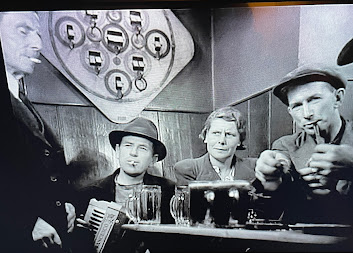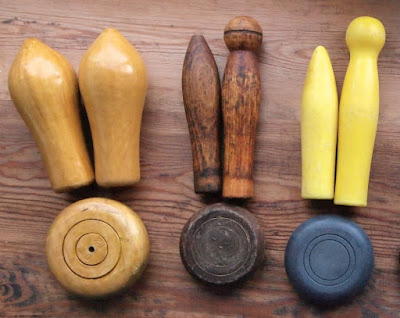A longstanding mystery object, and one that's already featured on this blog without a positive identification. Even the archivist at the National Brewery Museum in Burton-on-Trent was unable to find anything similar in their extensive records. This is from the original 2014 blog post with some minor editing:
Essentially a plain Mahogany box overlaid with a thick silvered copper plate, deeply engraved with an advert for Bass in Bottle. The perplexing aspect of this box is the two sets of drilled holes in the copper plate, 16 in total so presumably designed for two players, or two pairs of players scoring to 8. What appears to be the 'finishing' hole is offset as it is on a standard cribbage score board.
Despite engaging the opinion of experts in the fields of pub games and breweriana, the purpose of this box, and the identity of the game associated with it remains a mystery, though the size of the box suggests it would have housed a pack of Cards or set of Dominoes. The main issue being that the number of holes on the 'scoring board' don't correspond to any game that anyone can think of. I also have my suspicions that this object may have been locally crafted rather than manufactured specifically for the Bass Brewery as an advertising item. Certainly the metal plate appears to be 'correct', perhaps a re-fashioned and cut-down plaque that would have originally been mounted outside a hotel or smart club, but even this is proving difficult to identify. If anyone reading this has seen something similar, or has any idea what game this box might have been used to score, I would be delighted to hear their thoughts.
Mystery Pub #1
Just a little bit more clarity in this old photo and there would be all the clues needed for a positive ID. What can be discerned for sure is the swinging sign which gives the name as The Swan Hotel. The only part of the wall mounted signs I can make out for sure is that the hotel does 'Teas', and unfortunately the destinations on the road signs are indistinct, though it does appear to have A232 on the left-hand section giving a possible location of Surrey or surrounds. Judging by the motor car out front this could even be pre-war, and if the hotel is still standing it's likely the heavily pollarded tree is now gone.
Lion Ale Chalkboard
So probably not a club for the 'working class' games of Long Alley or Table Skittles. It's more likely that the Victoria Skittle Club would have been a well-appointed indoor alley, either in the style of a nine-pin 'bowling' alley such as the one at the Old Royal Navel College in Greenwich, or an alley for what we now call Old English Skittles. This latter game was once the standard skittles game throughout south-east England and probably as far north as the Midlands, with alleys established in the 'improved' pubs of the time, private members clubs, and sporting establishments. Whilst these skittles clubs were widespread and common (an alley is known to have existed at Melbourne Cricket Club in Australia!), only two such club remains in the capital now.
It's entirely possible that there are records of the Victoria Skittle Club in a dusty archive somewhere, although it's equally likely they would have been disposed of as being entirely unimportant at the dissolution of the club. There may also be clues in the names of the Chairman (Charles Johnson) and Hon Secretary (H W Griffin), who are likely to have been gentlemen of some standing in the local Leicester community.
Mystery Pub #2
Another unknown hostelry, and remarkably another pollarded tree marking the spot. Whilst it's doubtful the tree is still standing, this seems to be a more recent photograph given the cats eyes in the road so hopefully the pub still does. This one is clearly a Courage house, advertising their Alton Ales, Wines & Spirits, so possibly one of the 70-odd former Alton Brewery Co pubs acquired by Courage in 1903. This may put the pub in the Hampshire area, though nothing much else to go on other than the gables which appear to be distinctively curved.
A Shove Ha'penny Curiosity
The classic bar room game of Shove Ha'penny is one that I'm very familiar with, in fact it's one of my favourite pub games. A game that's still played competitively in some parts of the country so the rules are not exactly hard to come by. As it is, I have several books with the rules included, some dating back to the immediate post-war years when the game was very popular.One curiosity of the game is the single, very occasionally double (as shown here) 'D' zone adjoining the furthest bed. Not all Shove Ha'penny boards have this 'D', indeed most of the modern and earlier manufactured boards omit this feature (Pushpenny boards don't have them either), and yet very many early handmade examples do, but for what purpose I've yet to discover. The board shown here is unusual not only in having a double 'D', but also the corresponding zones at the side for chalking the score of what is effectively an extra two beds to the usual nine. So what was it for? My best guess is that it's a tie-breaker for a drawn game, or possibly used to decide who shoves first, or maybe just an extra bed for expert players to test their accuracy. I've used it occasionally as a 'Trump' bed whereby a coin landing squarely in the 'D' scores to any bed of the players choosing.
Shove Billiards
Clearly the concept of cannoning coins or tokens to score in the 'pockets' is the basis of the game, with all play from the bottom edge only. So I've a reasonable idea how the game worked, but not how it was actually played? So I'm hoping that someone out there may have their own Shuv or Shove Billiard board, and more importantly, know how to use it.
Medals
Another medal which seems to have more than enough information on the reverse for a positive ID is this one for Table Skittles, although even the game depicted is not entirely clear. Whilst the table shown bears a strong resemblance to a Kentish Daddlums Table, it's hard to draw a firm conclusion as these medals are often somewhat generic in subject matter. Nevertheless, it's an interesting medal from the inter-war years, the key to which is surely the S.T.S.T designation which is likely to be the club or league for this Cup Competition


































